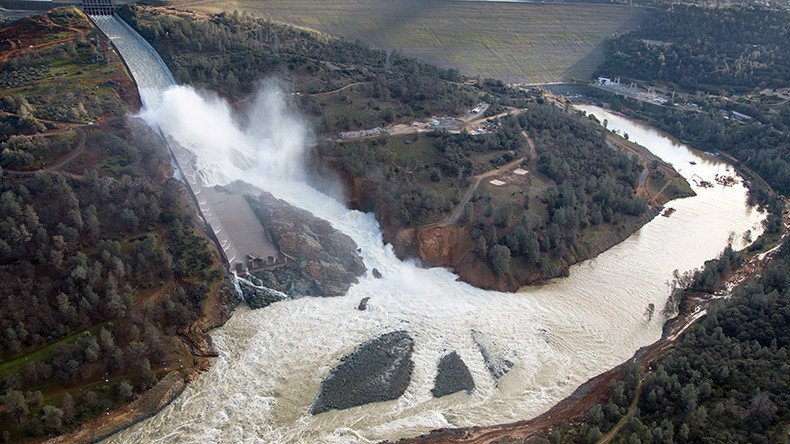'This is not good': Probe reveals mistakes in handling rupture at Oroville Dam

Managers at the 50-year-old Oroville dam, tallest in the US, misjudged the size of the massive rupture in its main spillway, according to new disclosures. The crisis led the evacuation of nearly 200,000 homes before catastrophe was averted.
Among the findings were that dam managers for six straight days thought there was no immediate danger, according to an exclusive report by the Associated Press.
The crisis began on February 7 following a massive storm which flooded the reservoir at the dam. The overflow coursed down the concrete spillway, left of the Oroville dam, the power of which ripped a hole the size of a football field in its wall.
Six days later the overflow was so great, water began surging down the emergency backup spillway, unpaved, and it started falling apart, too.
“They were futzing around with the main service spillway that had broken. They turned off the flow and were inspecting it and testing it,” Ron Stork, senior policy adviser with environmental group Friends of the River, told AP. “And all of the time the reservoir was filling.”
“And then it failed,” Stork said of the emergency spillway. “And you know, they almost lost control.”
Serious design, construction and maintenance defects doomed Oroville Dam, report says https://t.co/S4wqYO42d6pic.twitter.com/5gZU2STnAx
— Los Angeles Times (@latimes) April 18, 2017
Engineers had wanted to inspect the hole, study how much bigger it might get and think of a way to keep the spillway from crumbling further, state officials said.
Dam managers kept assuring the public there was “no imminent threat.”
It wasn’t until Sheriff Kory Honea overheard someone say, “That is not good,” that an evacuation of nearly 200,000 homes downstream happened.
“It was not whether people would die, but how many would die,” Honea told AP.
BREAKING: Oroville dam evacuation order lifted, warning remains https://t.co/4yY1FuTvV0pic.twitter.com/ddVR5bbiXf
— RT America (@RT_America) February 14, 2017
It was only then, after the evacuations, that dam managers ramped up water releases down the damaged main spillway, bringing the reservoir back down to safer levels.
The Oroville Dam is an earth-filled embankment dam in the Sierra Nevada foothills, east of Sacramento Valley. At 700 feet high, it is the tallest dam in the US, and serves the water supply and hydroelectricity for the San Joaquin Valley, which provides 12 percent of American’s agriculture.
Federal and state documents, obtained by the AP, showed overseers overestimated the durability of the two spillways.
In 2014, the Federal Energy Regulatory Commission affirmed the safety of both spillways and said there was no point in studying or discussing whether the possibility of either could fail, state officials told AP.
As early as 2005, however, Friends of the River and other environmental groups had argued the earthen spillway needed to be reinforced with concrete. The Department of Water Resources and local water agencies said that was unnecessary.
Department of Water Resource officials said during the crisis they were primarily worried the hole in the main spillway would grow larger and take out power-line towers at the dam’s hydroelectric plant.
A federally ordered investigation is under way into the crisis.
Meanwhile, a Nebraska-based company, Kiewit Infrastructure West, just won a roughly $275 million contract to repair the spillway, according to Sacramento’s Capitol Public Radio. The contract was nearly $44 million more than the state’s estimate but lower than two other competing bids.
The project will unfold in phases, with initial plans calling for a working spillway in place by November. Construction on a permanent spillway will start next year.











